
American summer tour! Wooclap will be at InstructureCon 2025
Come say hi at booth 41 from July 22nd to July 24th in Spokane, Washington
Poll Everywhere vs Kahoot vs Wooclap: Which Is Best for Online Learning in 2025?
30.05.2024 • 6 minutes
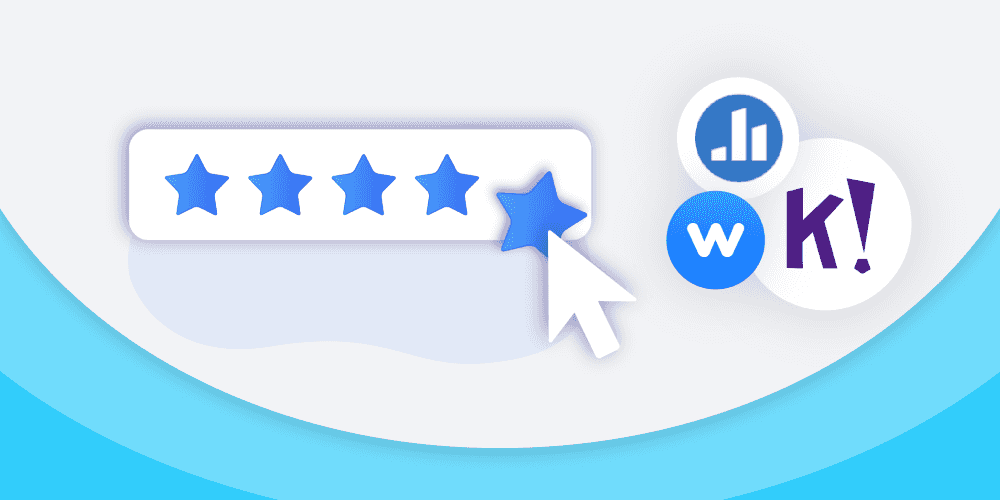
We tried and tested Poll Everywhere and Kahoot for two weeks to find their strengths, weaknesses, and ideal use cases. Here's what we found:
Poll Everywhere is a great platform for creating surveys, polls, and open-ended feedback forms without having to use a web form builder. Participants can easily respond to your questions over the web or via text messaging. It can be used to complement presentations, but its features make it particularly useful for making webinars more interactive. On the downside, it has an outdated user interface and relies on third-party integrations to get the most out of its features.
On the other hand, Kahoot, with its fun and vibrant UI, is the perfect tool for K-12 education. It’s the best platform for turning learning into a highly gamified experience by allowing students to create custom avatars, participate in competitions, and celebrate the top 3 students on a podium at the end. However, it’s not ideal in professional settings or higher education where understanding audience sentiment and taking questions in real-time come into play.
Since neither platform has the perfect blend of gamification and professionalism, we’ve included Wooclap in this comparison. We’ve been building Wooclap for almost a decade for precisely the use cases where those two are important.
Its diverse question types, fun but unobtrusive UI, presenter view, two-way interaction tools, and competitive mode make it perfect for higher education lecturers and professional training environments to encourage active participation, boost knowledge retention, and conduct comprehensive assessments.
Let’s take a closer look at Poll Everywhere vs Kahoot vs Wooclap and see how they compare in the following categories:
We’ll also touch on ease of onboarding, support, and user reviews in the comparison summary below to give you a comprehensive overview of each tool.
Poll Everywhere vs Kahoot vs Wooclap: Comparison Summary
| Poll everywhere | Kahoot | Wooclap |
 |  |  |
Price | ||
⭐️⭐️⭐️⭐️ The Free plan unlocks unlimited questions but is limited to 25 participants. Paid business plans start at $10/mo and go up to $249/mo (billed monthly) and are limited to 700 participants. Education plans are separate. | ⭐️⭐️⭐️ The Free plan allows 20-40 participants per event. Business plans for individuals go from $10 to $79/host/mo. Education plans for individuals go from $3.99 to $12.99/teacher/mo. Team plans are separate. | 🏆 ⭐️⭐️⭐️⭐️⭐️ The Free plan unlocks 1,000 participants per event and unlimited events. Education plans range from $6.99 to $14.99/teacher/mo. Business plans cost between $9.99 and $24.99/user/mo. |
Event Management | ||
⭐️⭐️⭐️ Live audience interaction using pinned questions. Uses third-party platforms for interactive presentations. No event templates. | ⭐️⭐️⭐️⭐️ Gather feedback and get audience performance reports after live events. Can’t take questions and comments during live events. AI-assisted question generator + event templates. | 🏆 ⭐️⭐️⭐️⭐️⭐️ Two-way live interaction + message categorization tool + AI-generated events and questions + event templates + presentation slide support. |
Question Types | ||
⭐️⭐️⭐️ 6 basic question types which can be combined to create additional two question types: surveys and competitions. Time-tracked questions. Limited gamification. | ⭐️⭐️⭐️⭐️ 6 question types for knowledge testing and 7 for collecting feedback. Highly gamified with variable scoring, leaderboards, and time responses. | 🏆 ⭐️⭐️⭐️⭐️⭐️ 21 question types with unique questions for brainstorming and collaboration. Over 50 templates covering business, education, and team activities. AI-generated questions. Moderate gamification that is suitable for higher learning. |
Reporting | ||
⭐️⭐️⭐️⭐️ Five report types for visualizing responses to questions. Includes a Gradebook report that shows a history of all responses for each participant. Export reports as CSV files. | ⭐️⭐️⭐️ 3 basic report types and a summary view of all event data. Export data as an Excel file. | 🏆 ⭐️⭐️⭐️⭐️⭐️ Four views of participant responses. Send individual reports to authenticated participants. Export event messages and reports as Excel and PDF. |
Ease of Onboarding | ||
⭐️⭐️⭐️⭐️ Has a support center with articles and guides on using the platform. Provides downloadable guidebooks for students, admins, and instructors. Has a YouTube channel with tutorial videos. | ⭐️⭐️⭐️⭐️ Has a help center with articles and FAQs and regularly organizes live webinars. Relies on its community to create video tutorials. | 🏆 ⭐️⭐️⭐️⭐️⭐️ Provides a help center, and YouTube channel that hosts monthly webinars and trains teachers to get familiar with the platform. |
Customer Support | ||
⭐️⭐️⭐️⭐️ Support via email and phone. Enterprise users get a dedicated success manager and priority support. | ⭐️⭐️⭐️⭐️ Submit requests via online forms. Response times can be long at times, however, this may not be the case for premium users. | 🏆 ⭐️⭐️⭐️⭐️⭐️ Access support via a contact form, in-app chat, or email. Enterprise users get dedicated support. |
Used By | ||
🏆 ⭐️⭐�️⭐️⭐️⭐️ Tulane University, Education Design Lab, Making Teams Work, Aetna | 🏆 ⭐️⭐️⭐️⭐️⭐️ Kempinski Hotels, Ree Park Safari, AND Digital | 🏆 ⭐️⭐️⭐️⭐️⭐️ Maastricht University, Total Energies, Kellogg’s |
Best for | ||
🏆 ⭐️⭐️⭐️⭐️⭐️ Tulane University, Education Design Lab, Making Teams Work, Aetna | 🏆 ⭐️⭐️⭐️⭐️⭐️ Kempinski Hotels, Ree Park Safari, AND Digital | 🏆 ⭐️⭐️⭐️⭐️⭐️ Maastricht University, Total Energies, Kellogg’s |
What is Poll Everywhere?
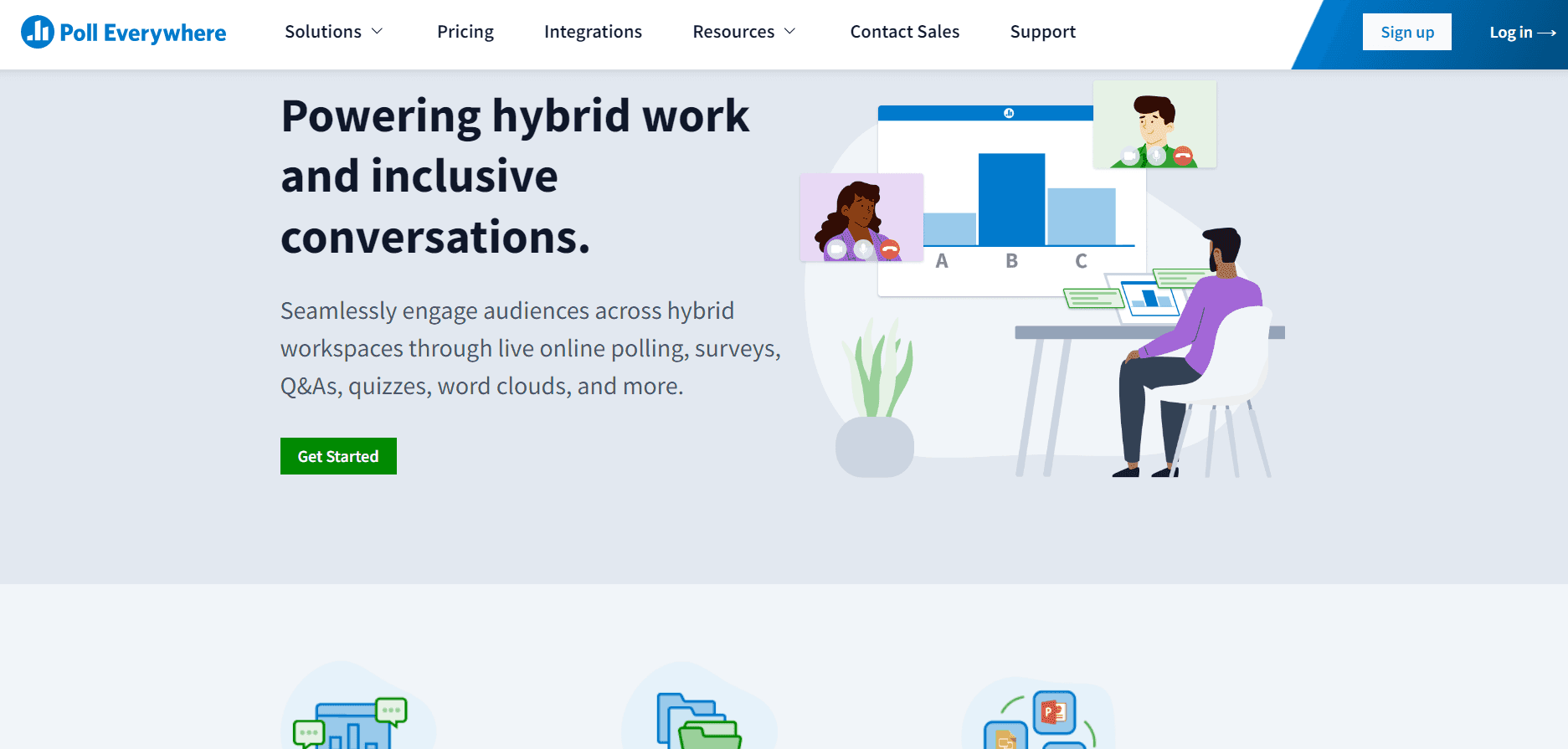
Jeff Vyduna, Brad Gessler, and Sean Eby were coworkers tasked with hosting internal presentations. One day, to keep the audience engaged, they decided to conduct a poll through cell phones. One thing led to another, and in 2007, Poll Everywhere debuted as an online service for audience response systems.
Poll Everywhere is a web-based audience response system with several features to facilitate interactive presentations and gather real-time feedback. It can create live polls, word clouds, quizzes, competitions, Q&As, and more. Plus, it uses various response methods including via text message, web browser, or mobile app, ensuring accessibility for diverse audiences. Poll Everywhere also integrates with presentation tools like PowerPoint, Google Slides, or Keynote, seamlessly incorporating interactive elements into existing presentations. After each presentation, it generates reports on audience engagement metrics, including response rates, scores, and rankings.
Poll Everywhere isn't designed to host events but it can integrate with presentation and collaboration platforms, as well as learning management systems. This makes it a great option for individuals and small teams that need a quick and easy tool for creating surveys and other audience feedback systems.
What is Kahoot?
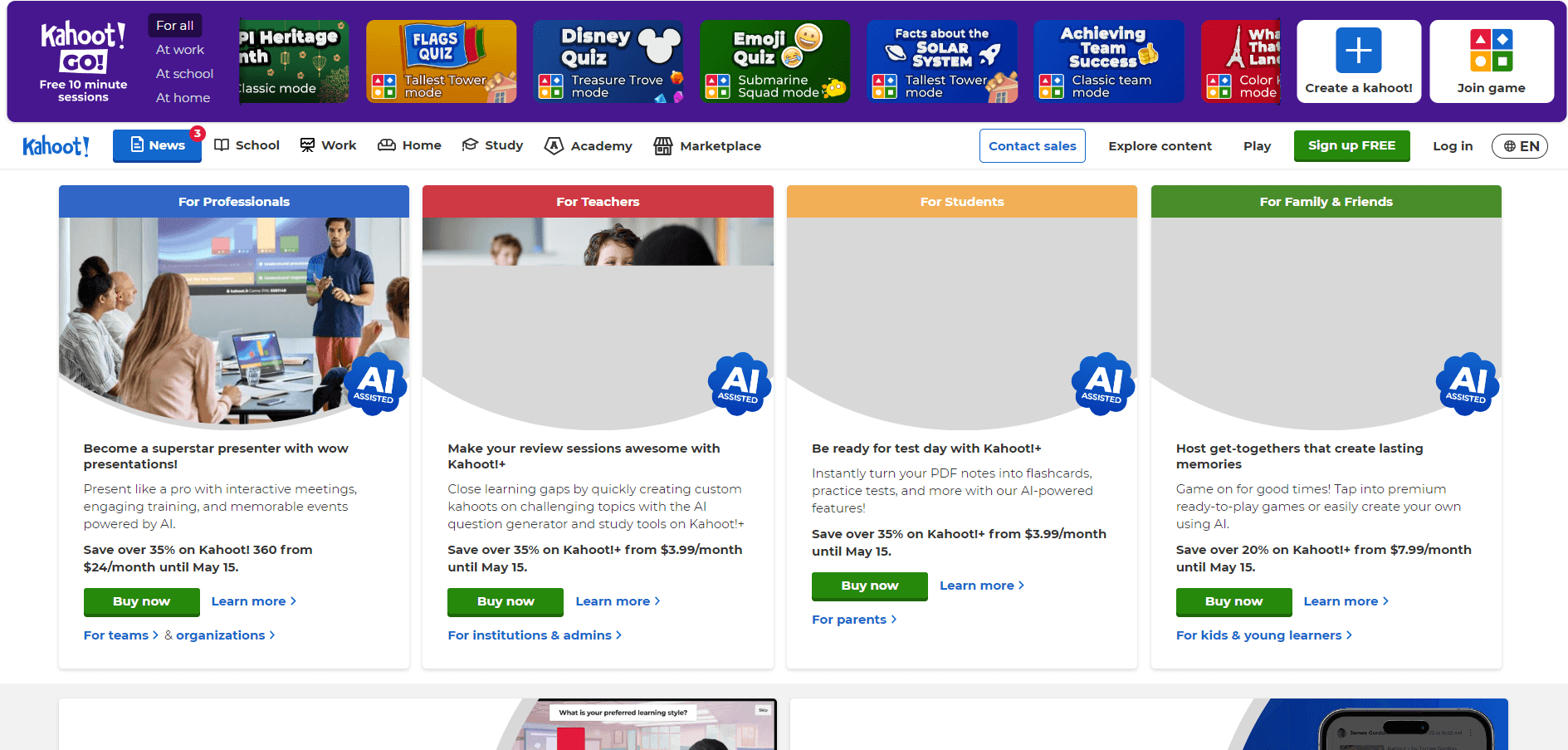
Morten Versvik teamed up with Professor Alf Inge Wang to work on “Lecture Quiz” as a research project. The goal was to unlock the learning potential of students of all ages by making learning fun and enjoyable. Ever since its official launch in 2013, Kahoot has engaged over 10 billion participants across 200+ countries.
Kahoot excels in making learning fun through games. It has a large library focused on K12 topics and general trivia and allows users to make custom quizzes. After each question and at the end of a quiz, the scores are revealed to encourage healthy competition. Students can even create their own avatars before a session—yet another way to personalize the experience and engage kids. Some other notable features include background music, randomizing questions and answers, and collecting feedback.
The playful, competitive, and gamified experience makes Kahoot great for K-12 teachers aiming to enhance classroom engagement and participation. However, the colorful and playful approach isn’t suitable for professional settings or higher-education lectures.
What is Wooclap?
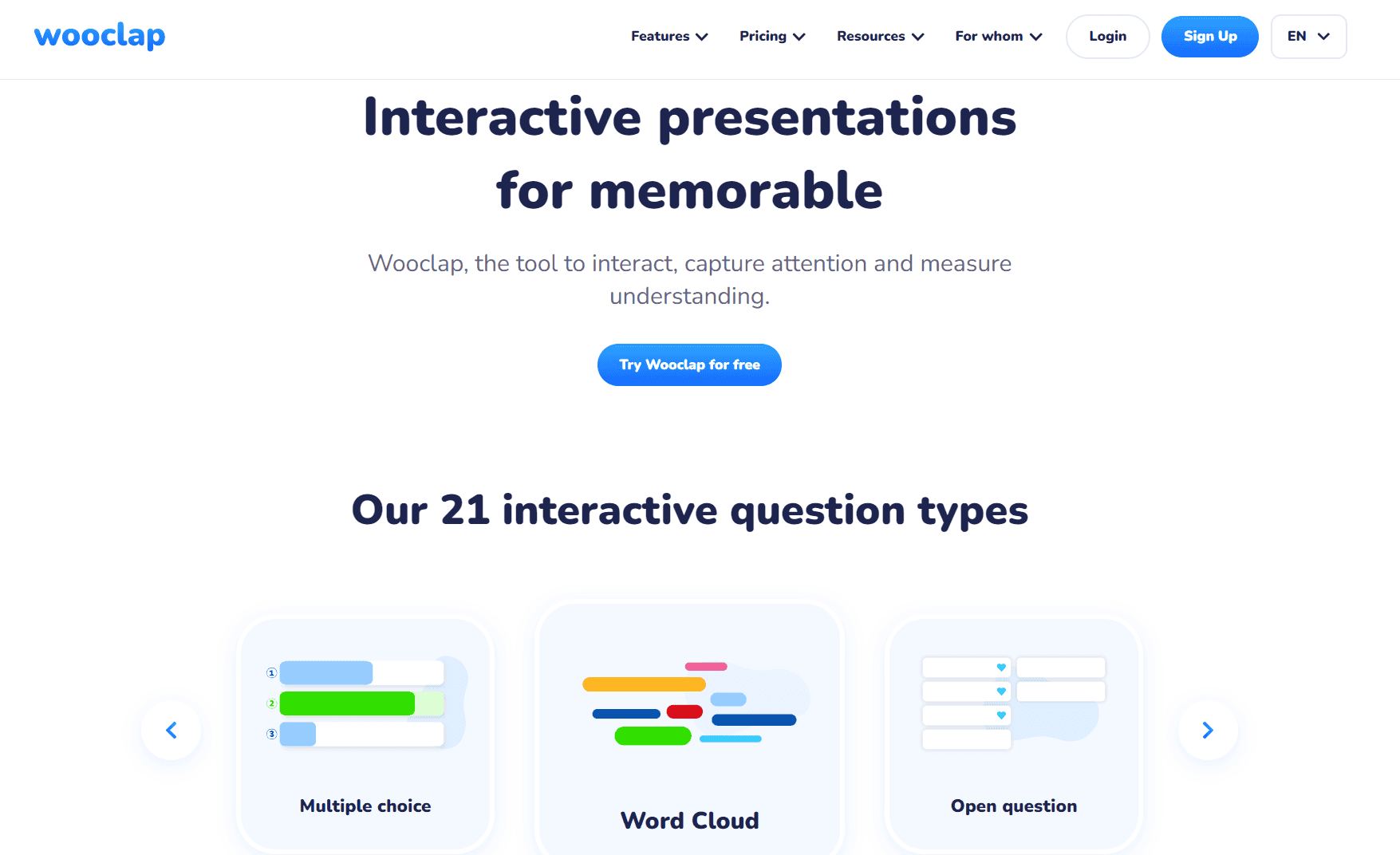
Sébastien Lebbe and Jonathan Alzetta met at a lecture hall and bonded over their love of technology and learning. They noticed teachers were having a tough time capturing and retaining student attention, so they launched Wooclap with the help of veteran educators, neuroscientists, and tech experts. Since 2015, it’s grown to serve 50+ million users globally.
Wooclap’s roots in neuroscience show through tools, based on modern learning best practices. Its most valued feature, the numerous question types, allows students to engage with interactive exercises that help with knowledge retention. On the other hand, this enables teachers to gauge where students get confused in real time. After a learning session, teachers also get detailed reports on student performance and can send feedback. Wooclap also allows integrations with every common learning management system, allowing learning organizations to plug it seamlessly into their curriculum.
Wooclap supports some gamification features with its ‘competition mode’ but its main focus is on higher education classrooms and employee training where knowledge retention is the priority. Its toolbox is geared for learning and understanding more complex topics.
Poll Everywhere vs Kahoot vs Wooclap: Event Management
| Poll Everywhere | Kahoot | Wooclap |
| ⭐️⭐️⭐️ | ⭐️⭐️⭐️⭐️ | ⭐️⭐️⭐️⭐️⭐️ |
Poll Everywhere and Wooclap allow live two-way interaction during events, while Kahoot only allows feedback at the end.
Poll Everywhere uses Activities to ask questions, collect feedback, and interact with audiences during events.
It allows you to pin activities, keeping them open in the background even as you collect responses to other questions. With this, you can watch upvotes, downvotes, and other submissions to your pinned activities come in live.
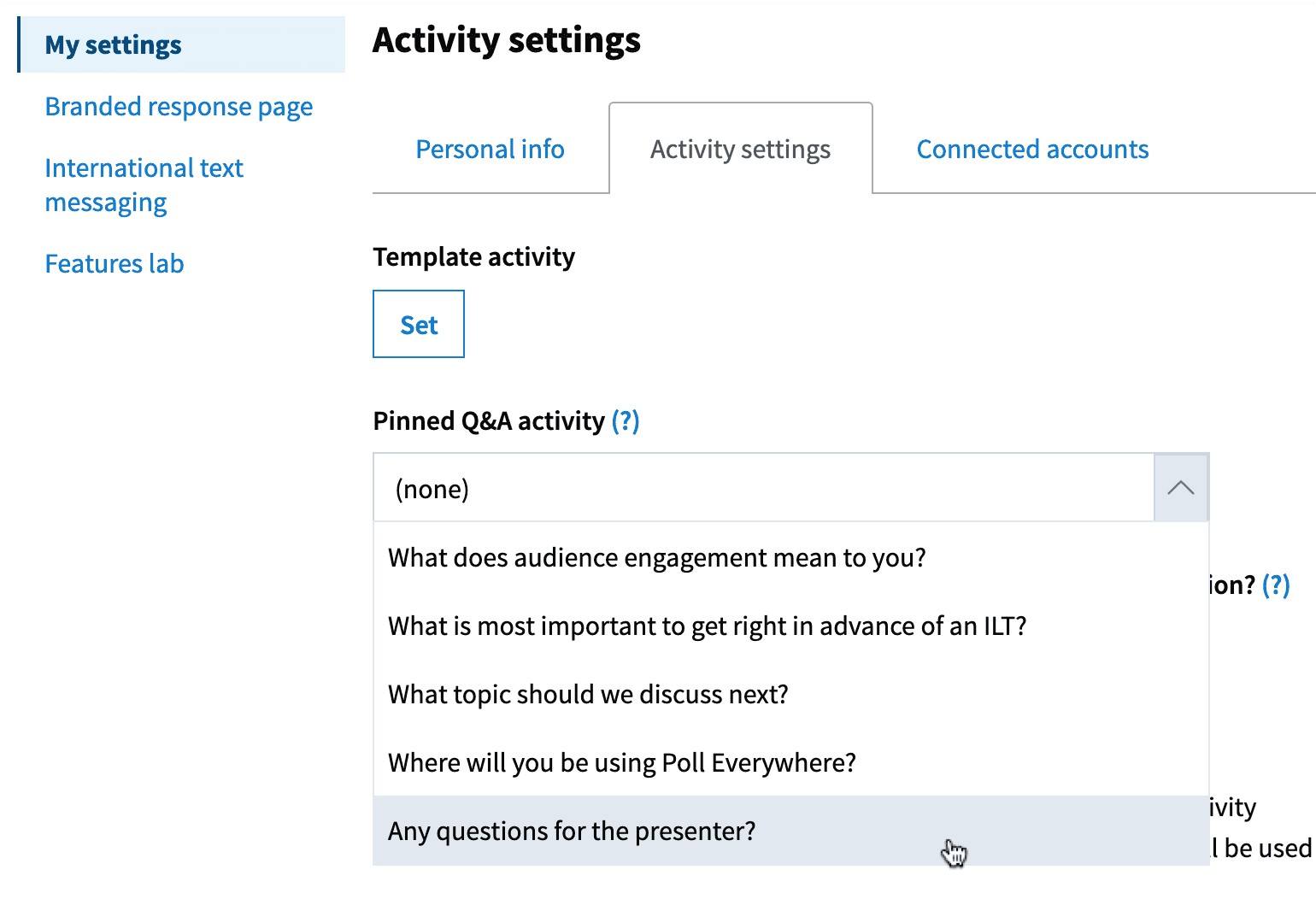
Poll Everywhere also includes live moderation—allowing you to see responses before displaying them on-screen to prevent inappropriate submissions.
Wooclap outdoes Poll Everywhere with a real-time messaging system.
Students can send messages and images to the Message wall, allowing them to express ideas, ask questions, provide feedback, and more, without having to speak up. They can also like each other's messages, showing what your audience is most interested in.
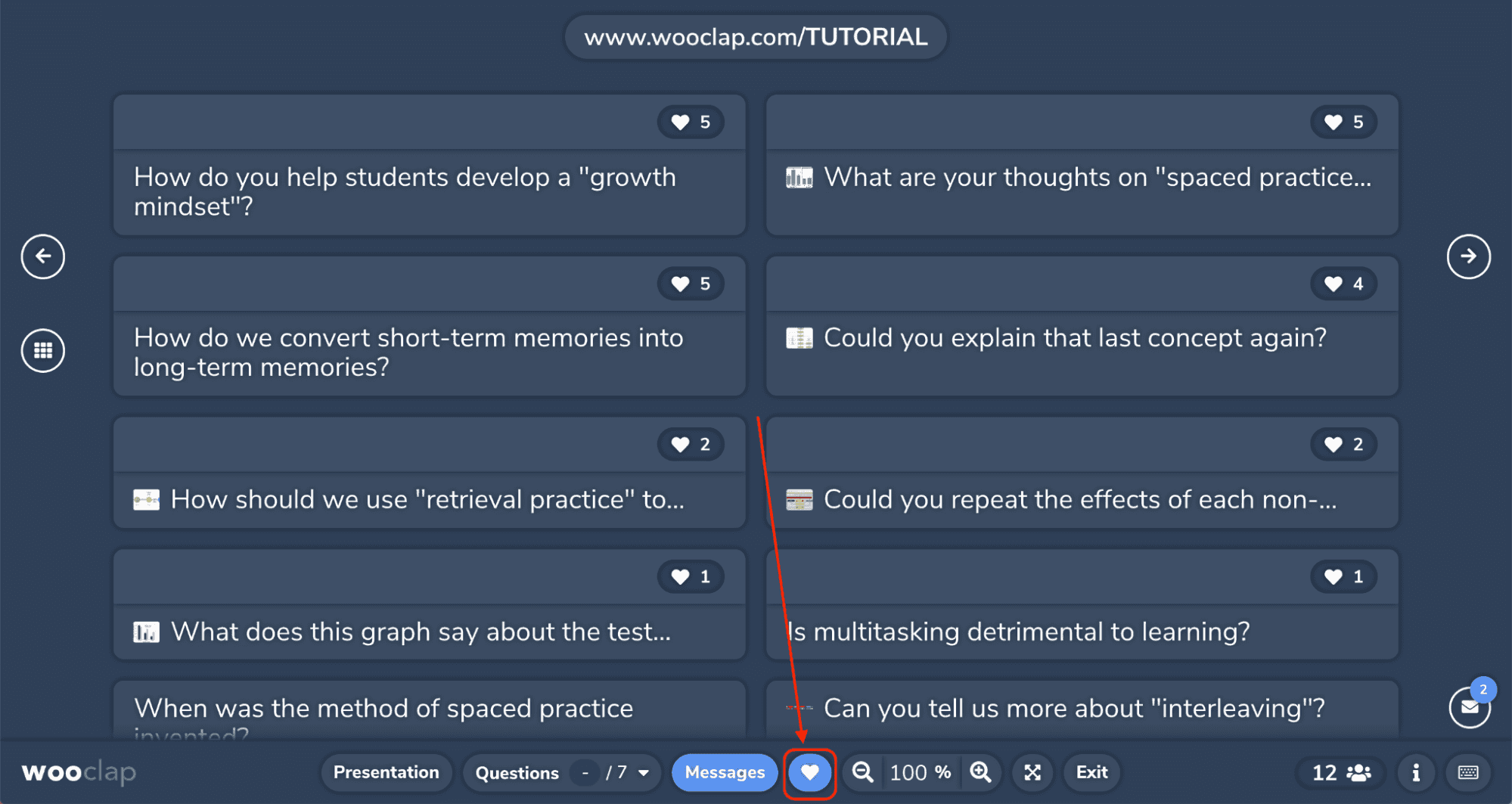
When presenting, you can assign different color tags to student questions, making it easier to categorize and address them effectively.
For even more detailed feedback, you can create questionnaires for students to fill out at their own pace, even during the event. As long as the questionnaire is online, students can send responses and review their performances when done.
But that's not all.
The “I’m confused” button is a handy feature that helps you understand how well your audience is following your lectures or seminars, without anyone in the audience having to speak up. It shows the number of confused participants in real-time at the top of your presentation, and you can reset it after resolving the issue.
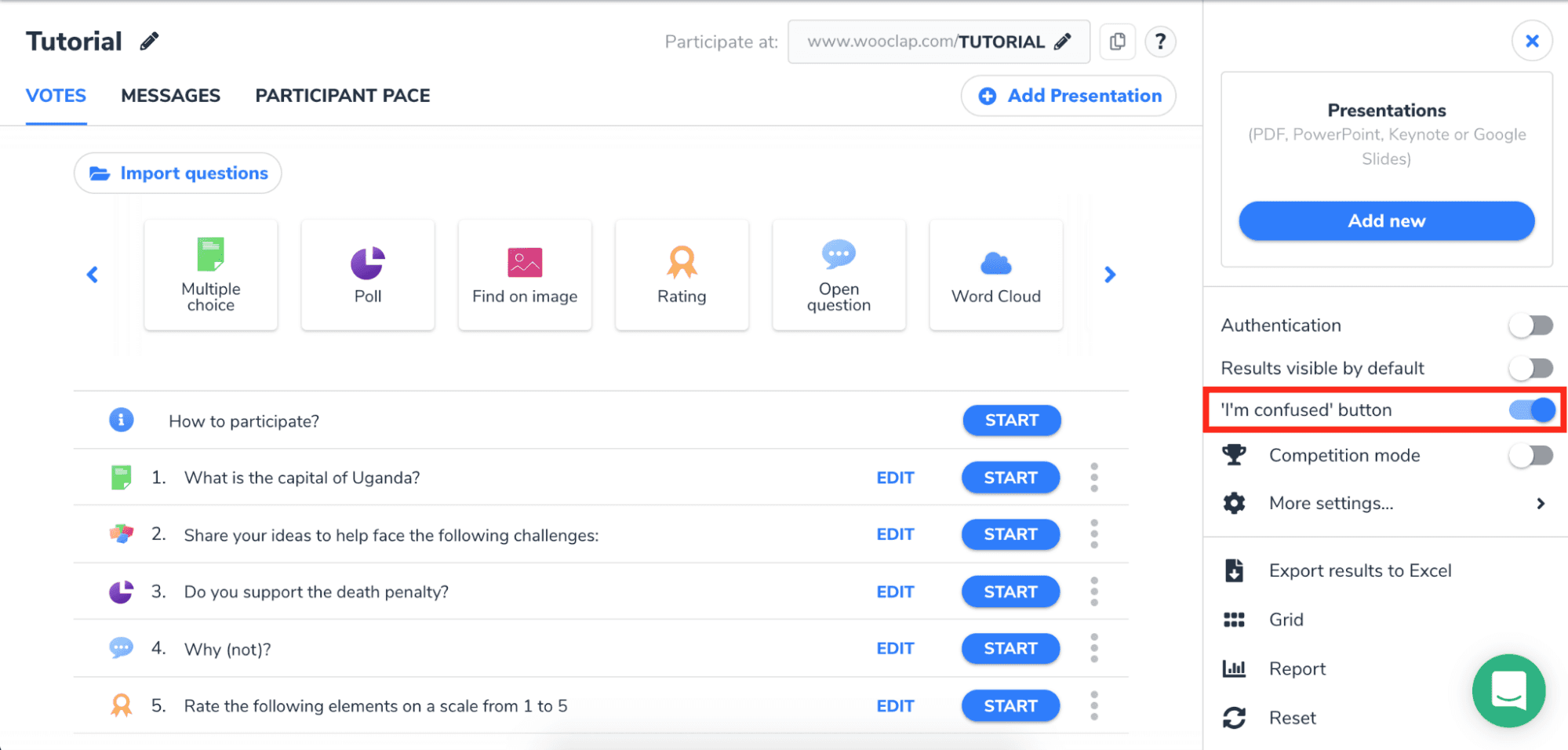
Kahoot doesn’t have messaging features. But it does offer a Kahoot live class with interactive tools available.
Instructors only receive basic feedback when students recommend the Kahoot and provide an overall rating. Students can also state whether they learned something new during the presentation.
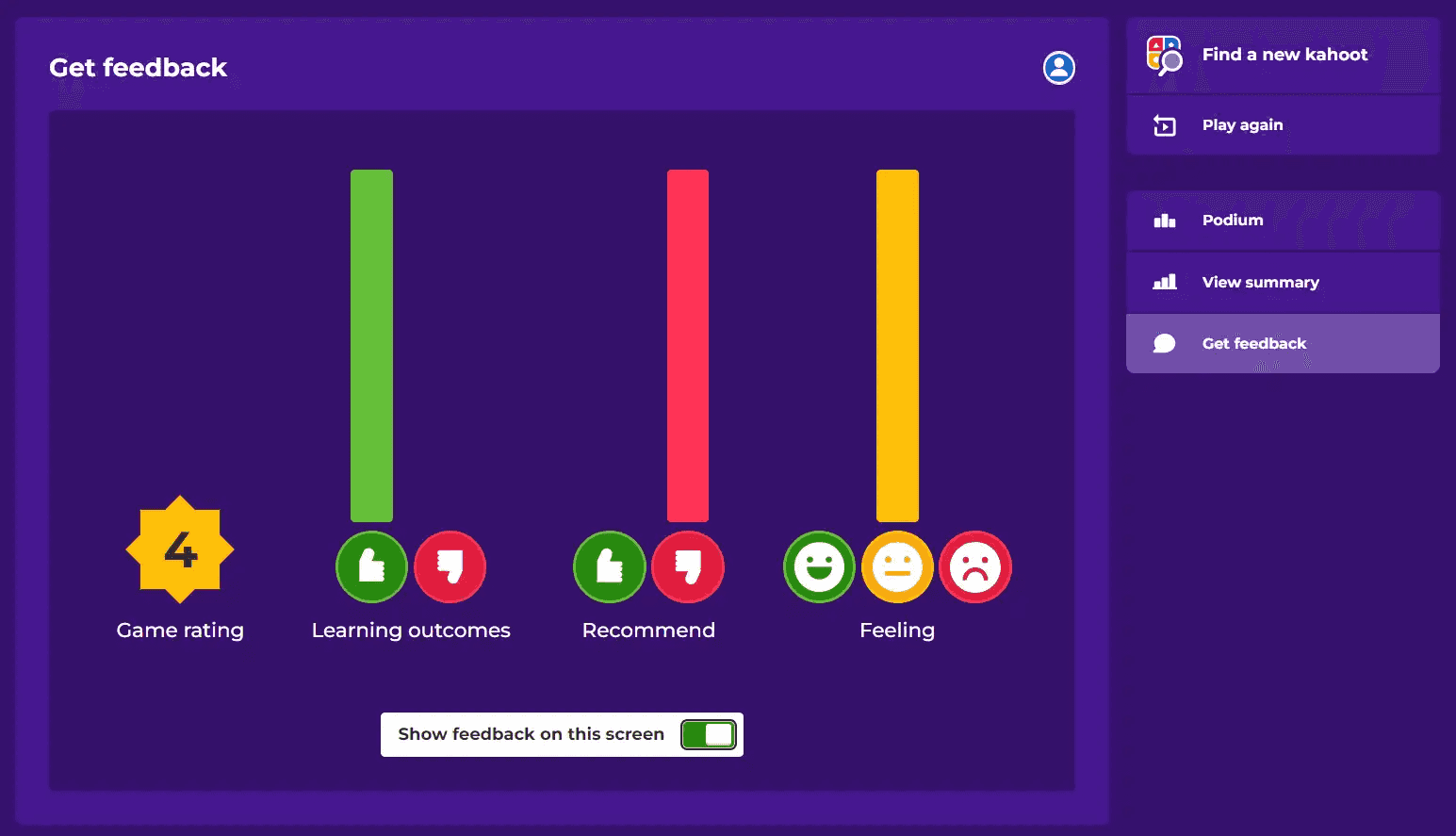
All three support presentation slides, but Wooclap offers more options.
Poll Everywhere doesn’t offer built-in support for presentation slides.
However, you can use third-party presentation software like Microsoft PowerPoint, Google Slides, Zoom, and Microsoft Teams to activate questions and display live results on your slides.
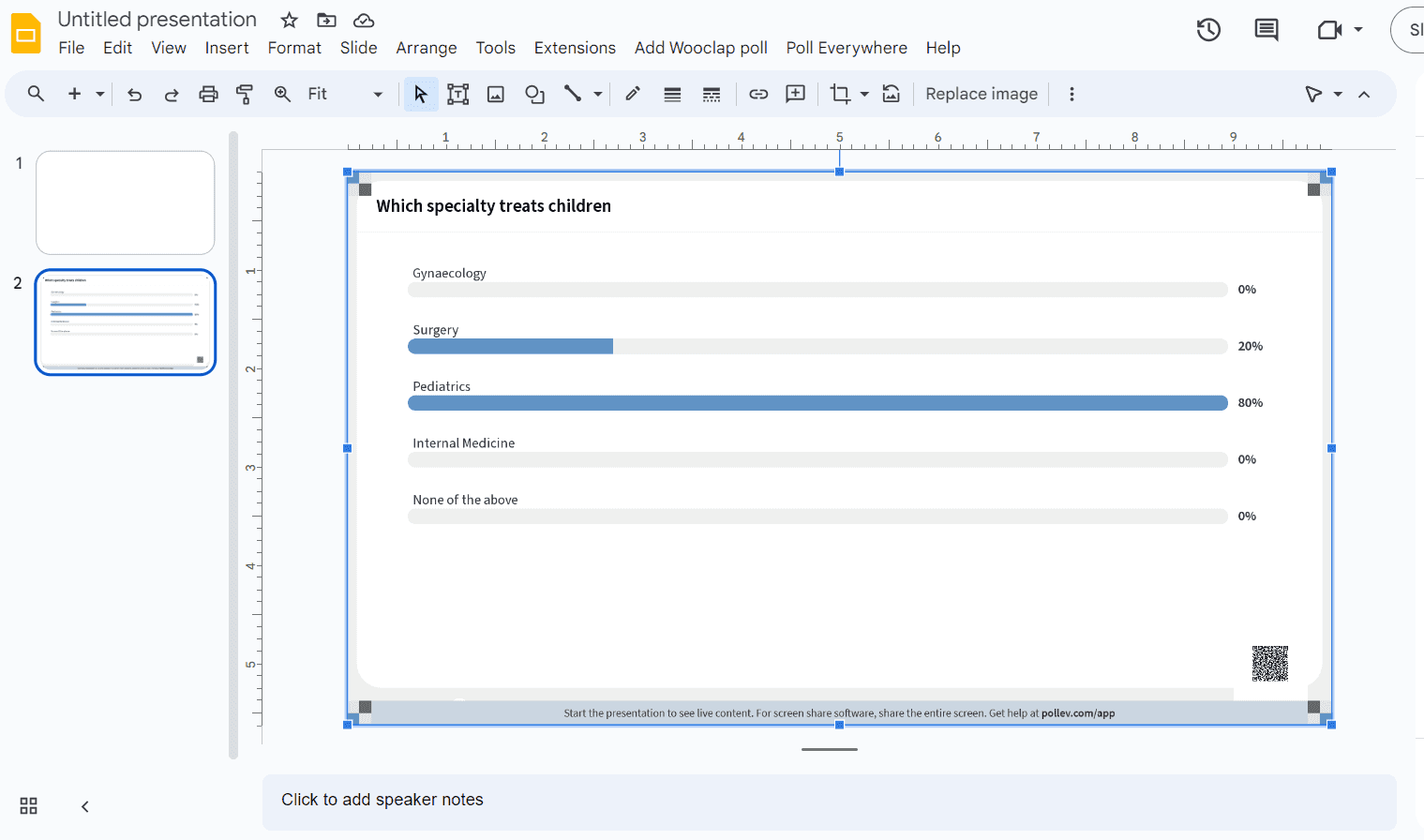
With the Slack integration, you can incorporate polls and real-time messaging into your events. However, the interface feels slow and unintuitive.
Kahoot lets you import slides from a PowerPoint, PDF, or Keynote and use them to build presentations for your Kahoot event. However, it converts these slides into static images, so you lose editing capabilities, as well as any animations and transitions from the original document.
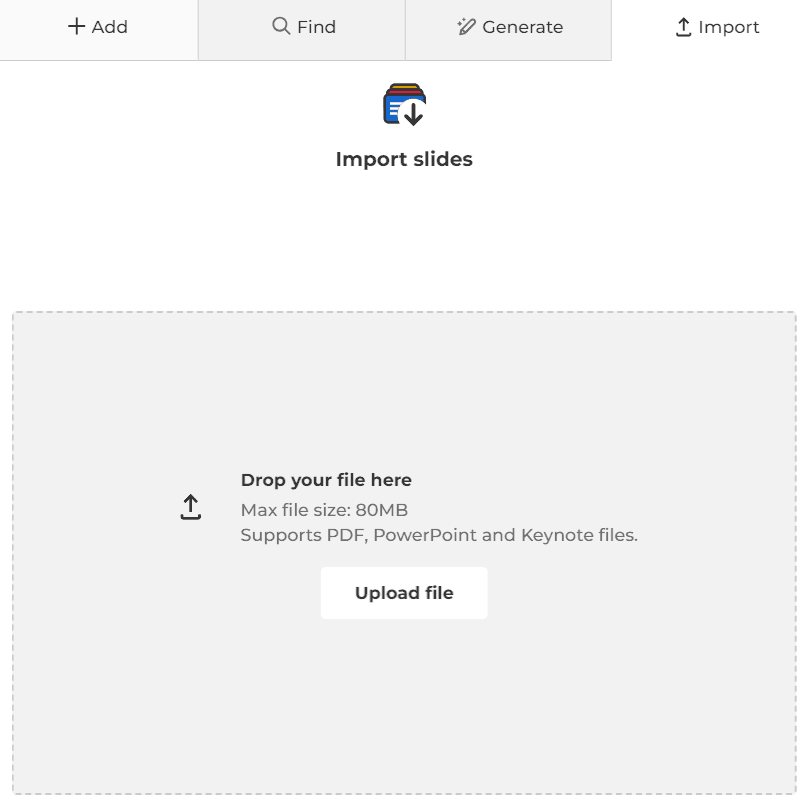
In addition to importing slides, Kahoot offers integrations with Microsoft Teams, Zoom, Hopin, and Microsoft PowerPoint, allowing you to host events directly from these platforms. But, it doesn’t support Google Slides integration.
Wooclap integrations, on the other hand, include Google Slides, as well as almost all platforms supported by Poll Everywhere and Kahoot. Additionally, they include unique integrations like Moodle, Brightspace, and Canvas.
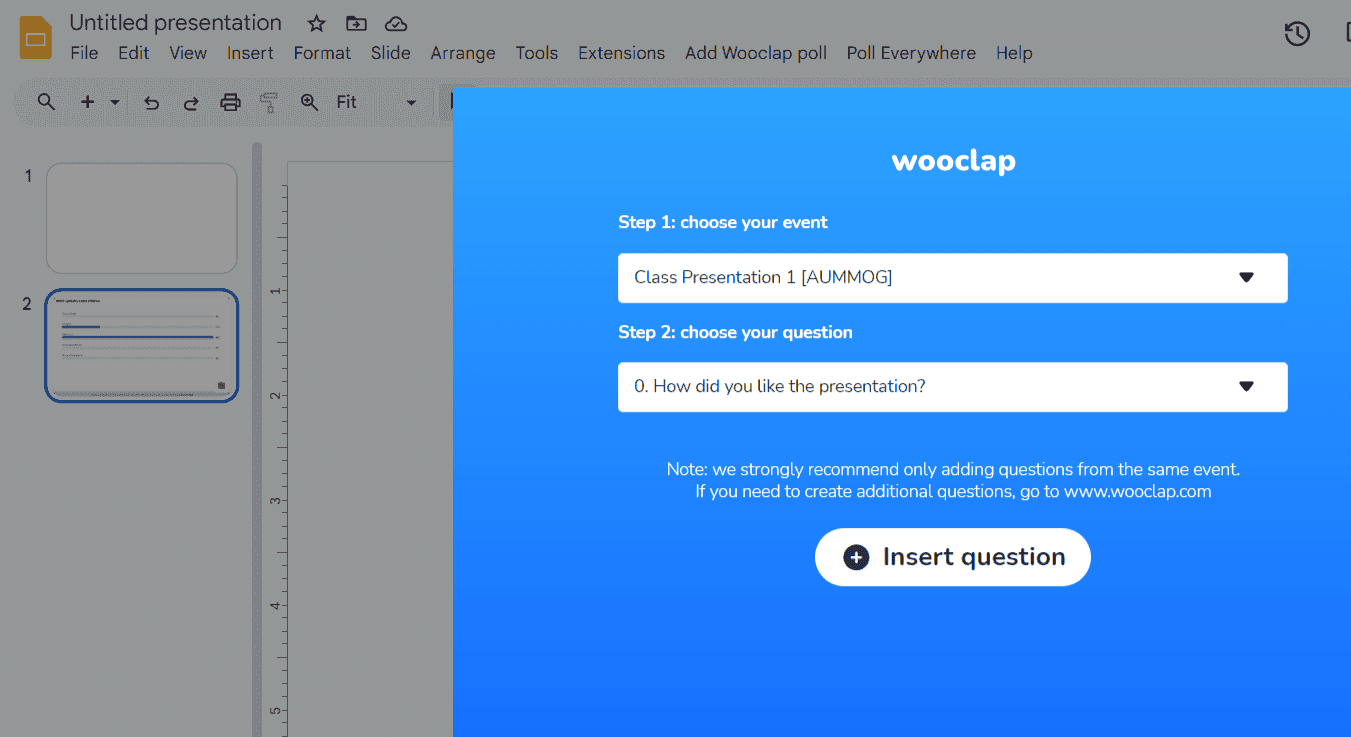
The Moodle integration, in particular, allows teachers to access all of Wooclap’s features without leaving the platform. It also synchronizes the results of Wooclap events with students’ gradebooks.
Like Kahoot, Wooclap offers built-in presentations, which you can import from a PDF or PowerPoint file. It lets you use the in-app editor to insert questions between slides and display the results in real-time when presenting. Additionally, you can upload presentation files in the Participant Pace section as part of the event’s training material.
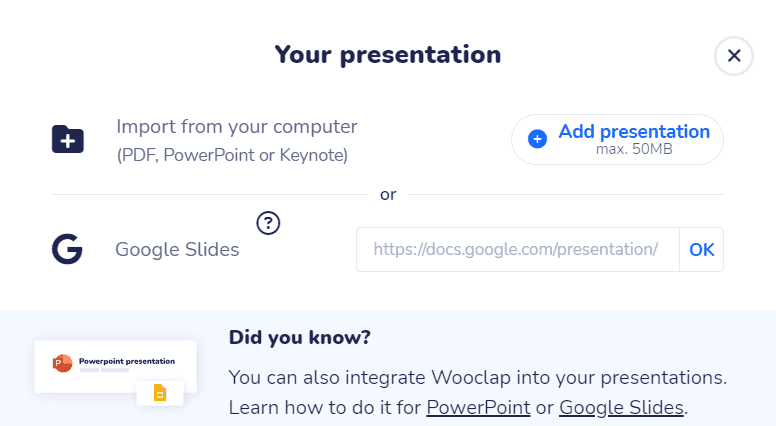
Kahoot and Wooclap offer event templates, while Poll Everywhere doesn’t offer any.
Kahoot offers 20+ templates that serve as a starting point for your business events. These range from icebreaker games to onboarding selfies and brainstorming meetings.

You also get an AI-assisted question generator that creates games from the contents of a PDF file or an input topic.
Wooclap also provides a public event template library with over 50 templates, covering all kinds of areas like education, business & training, feedback, co-creation, knowledge evaluation, and icebreakers.
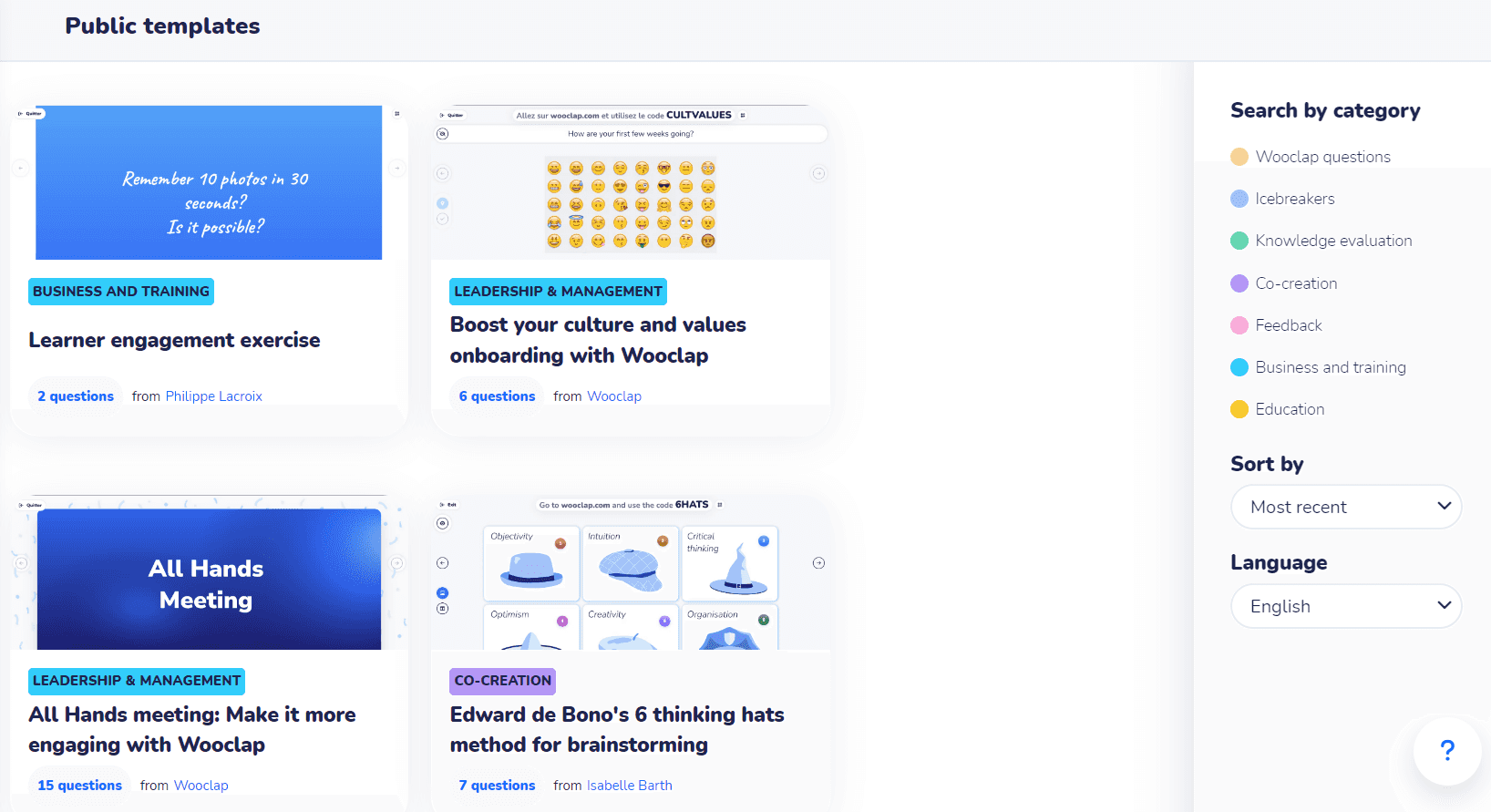
In addition to the template library, you can import events from a colleague’s account using the author’s event code. And, the Moodle integration lets you import questions in XML format. This way, you can copy, create, and reuse events on the go.
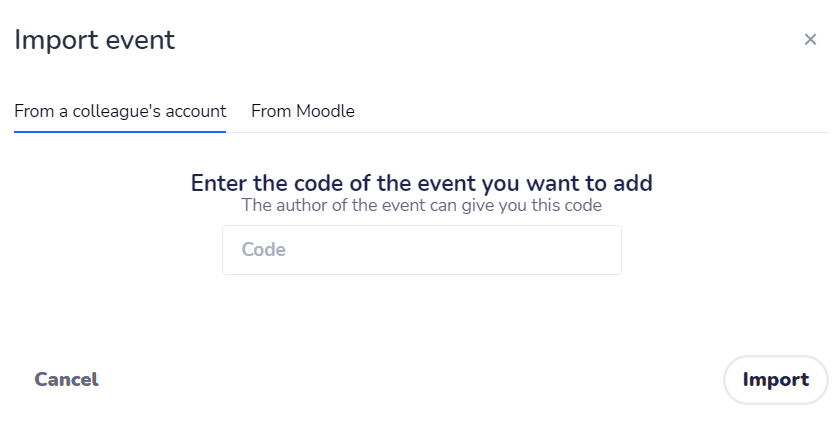
Poll Everywhere doesn’t offer any event features or templates. Instead, you create individual questions as Activities and activate each of them manually.
Wooclap wins for addressing the event management shortcomings of the other platforms. Kahoot offers built-in presentations but limits third-party integrations, while Poll Everywhere offers lots of integrations but no built-in presentations. Wooclap provides full support for both types of event presentations and tops it off with two-way messaging.
| Poll Everywhere | Kahoot | Wooclap |
| ⭐️⭐️⭐️ | ⭐️⭐️⭐️⭐️ | ⭐️⭐️⭐️⭐️⭐️ |
Poll Everywhere vs Kahoot vs Wooclap: Question Types
| Poll Everywhere | Kahoot | Wooclap |
| ⭐️⭐️⭐️ | ⭐️⭐️⭐️⭐️ | ⭐️⭐️⭐️⭐️⭐️ |
Poll Everywhere has 8, Kahoot 13, and Wooclap 21 question types.
Poll Everywhere has 8 question types that let you engage participants and collect feedback:
- Q&A,
- ranking,
- word cloud,
- open-ended,
- multiple choice,
- clickable image,
- survey,
- and competition.
Surveys combine multiple question types for detailed responses. And Competitions consist of one or more multiple-choice questions, along with scores for each question.
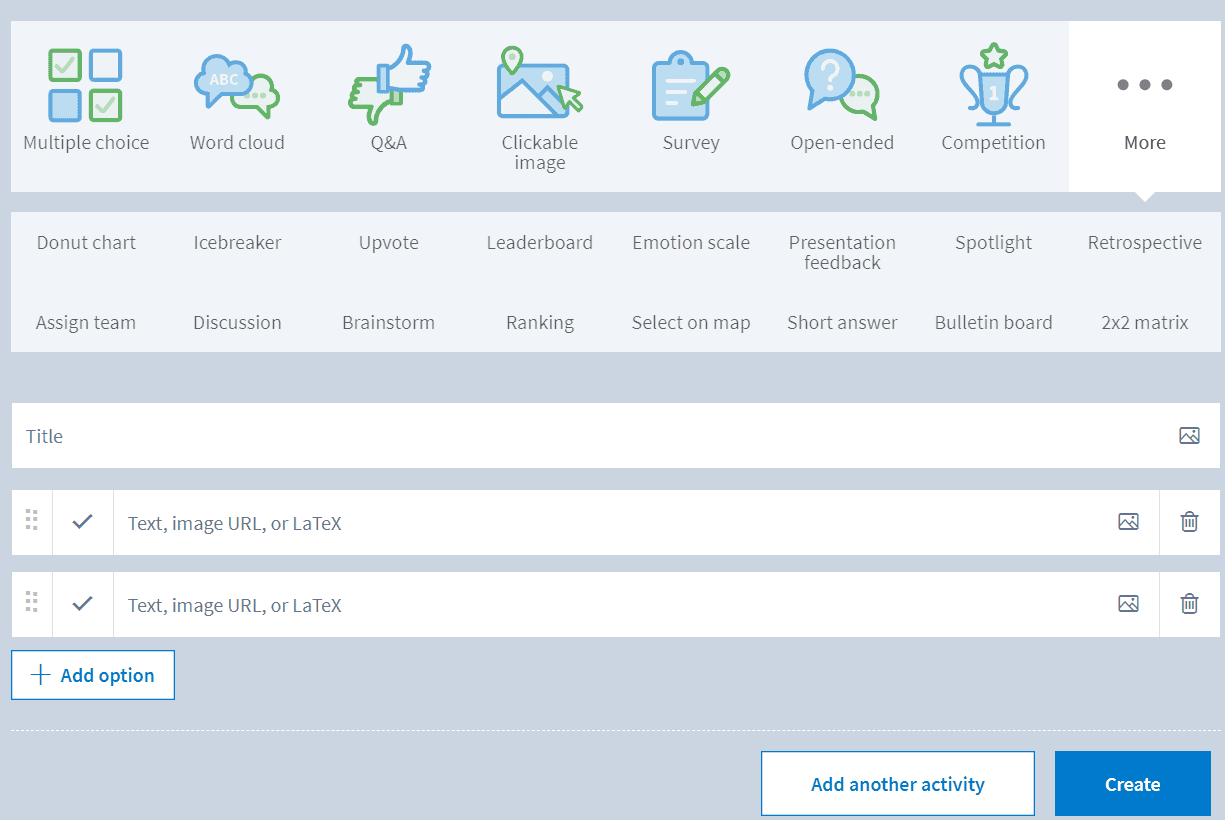
Poll Everywhere can receive responses through a special activity URL or by text message. And, you can set how many responses each participant is allowed to send, as well as a timer to limit participant response time.
Kahoot has 6 basic question types for testing knowledge, scoring, and ranking participants:
- quiz,
- slider,
- puzzle,
- pin answer,
- type answer,
- and true or false.
You can specify the right answers, set a time limit, and select a scoring method.
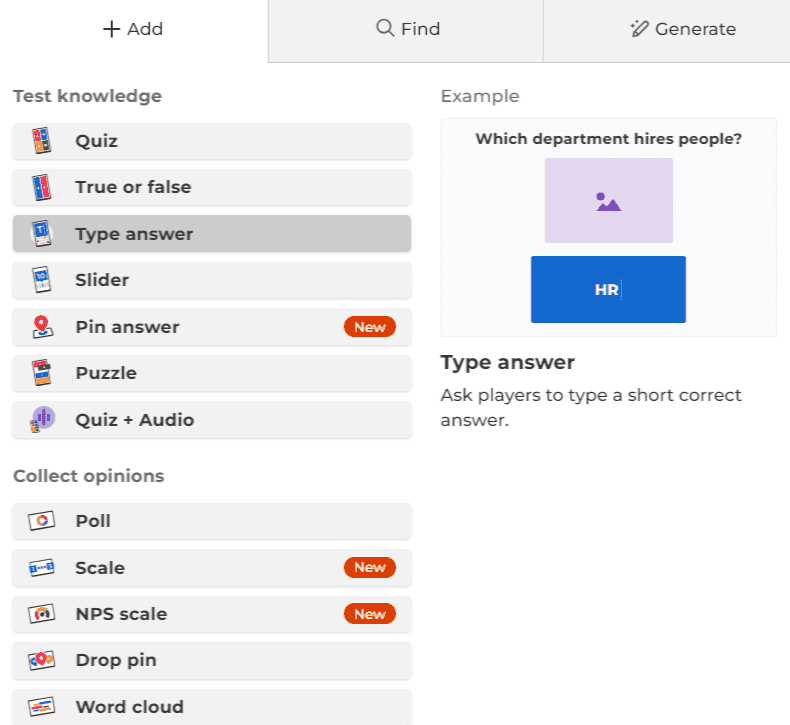
If you want to collect feedback and encourage discussions, Kahoot offers 7 additional question types including poll, brainstorm, word cloud, NPS scale, and drop pin.
When it comes to collecting responses, Wooclap is unmatched with its whopping 21 question types for assessing student comprehension, collecting feedback, and showcasing information.
It features similar assessment question types to Poll Everywhere and Kahoot but stands out with unique ones like:
- Matching — students pair related items.
- Fill in the blanks — students complete a given text with missing words and phrases.
- Label an image — an engaging way to test knowledge using diagrams or pictures.
In addition to standard feedback question types like polls, ratings, and word cloud, Wooclap also includes collaborative formats to facilitate brainstorming and idea collection. Notable ones include:
- Framework — facilitates group collaboration with predefined categories that guide users' contributions, allowing for a more structured and focused group discussion.
- Brainstorming — lets you create interactive boards where users can submit and vote on each other's ideas.
- Whiteboard — fill a blank canvas with users’ ideas, allowing all participants to co-create visual representations of ideas.
Poll Everywhere has limited gamification, Kahoot is the most playful, while Wooclap is the most flexible.
Poll Everywhere lets you limit the time participants have to answer each question in a Competition. You can set the timer anywhere from 5 seconds to 180 seconds but you can't set individual timers for each question.
When using timed responses, each question starts with a score of 1,000 points and decreases as time passes. This means that the longer participants take to answer a question, the lower their score.
Without the timer, each question is scored solely on correctness, creating an “all or nothing” style Competition.
With Kahoot, you can award standard points for a question, double the points, or give no points at all. You can also set a timer that affects the score.
After each question, Kahoot automatically displays the top 5 ranked participants. It also gives special shoutouts to players on an answer streak or those who move up three or more spots. When the competition is over, it shows the top 3 players on a special podium.
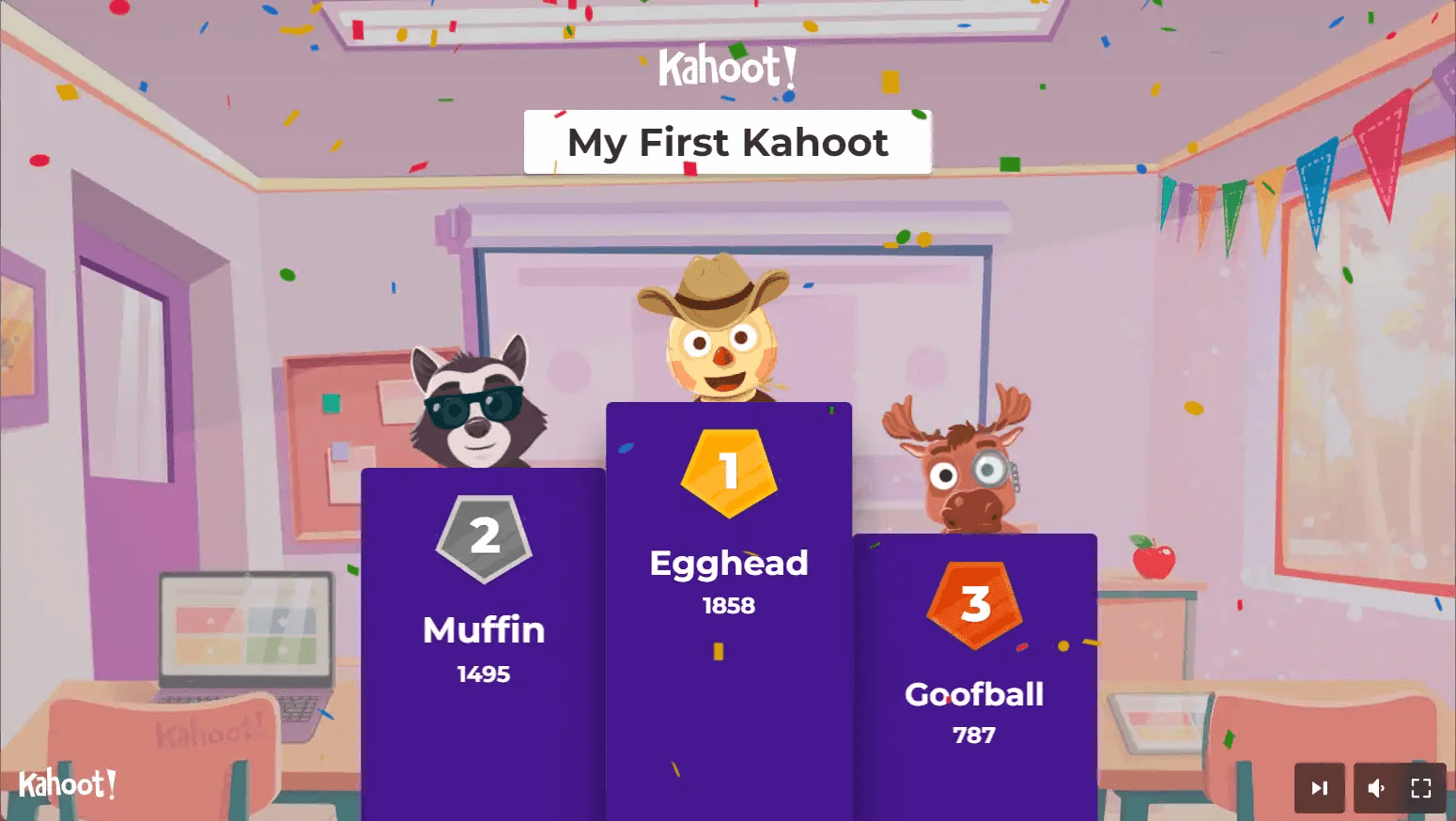
Kahoot doesn’t support anonymous responses. Instead, participants must create avatars before joining a competition. While this offers a fun and engaging experience for kids, it may be off-putting for higher education or corporate participants.
Like Poll Everywhere, Wooclap lets players participate with or without nicknames, as well as anonymously. And, in Competition mode, you have more control over when and how to display player rankings than Kahoot.
You can show the top 3, 5, 10, or 15 participants and their scores on the leaderboard with the toggle of a button. Meanwhile, participants see their scores and rank on their screens.
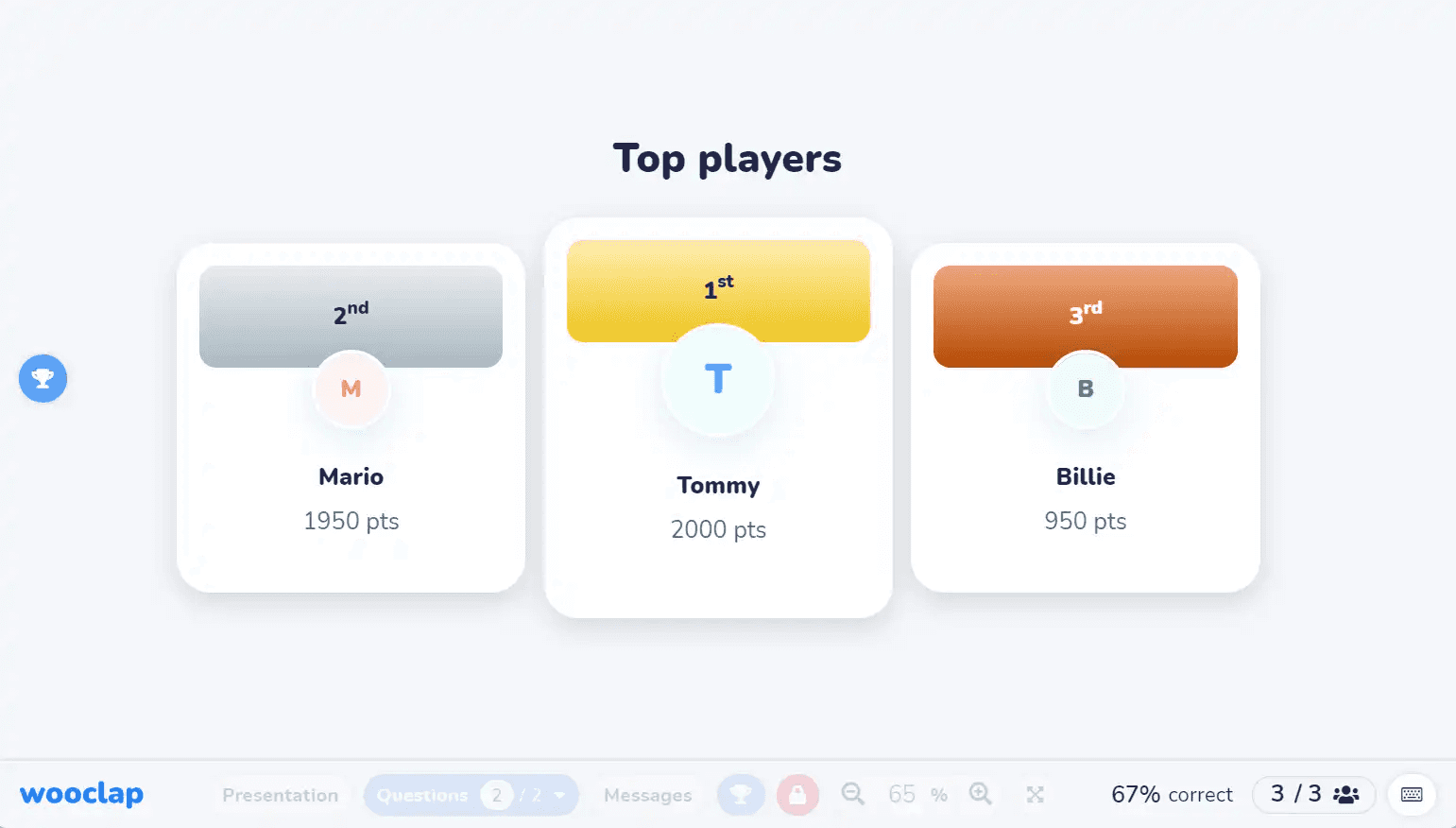
Wooclap also offers timed responses, which you can set individually on each question, or all questions at once.
In Competition mode, points are awarded according to the speed and correctness of your answers. This means the first correct answer gets maximum points while subsequent responses get fewer.
Kahoot and Wooclap offer templates and AI-generated questions, while Poll Everywhere doesn't.
When adding questions in Kahoot, you can pull them from your library or the community-driven question bank, based on themes, keywords, filters, and type.
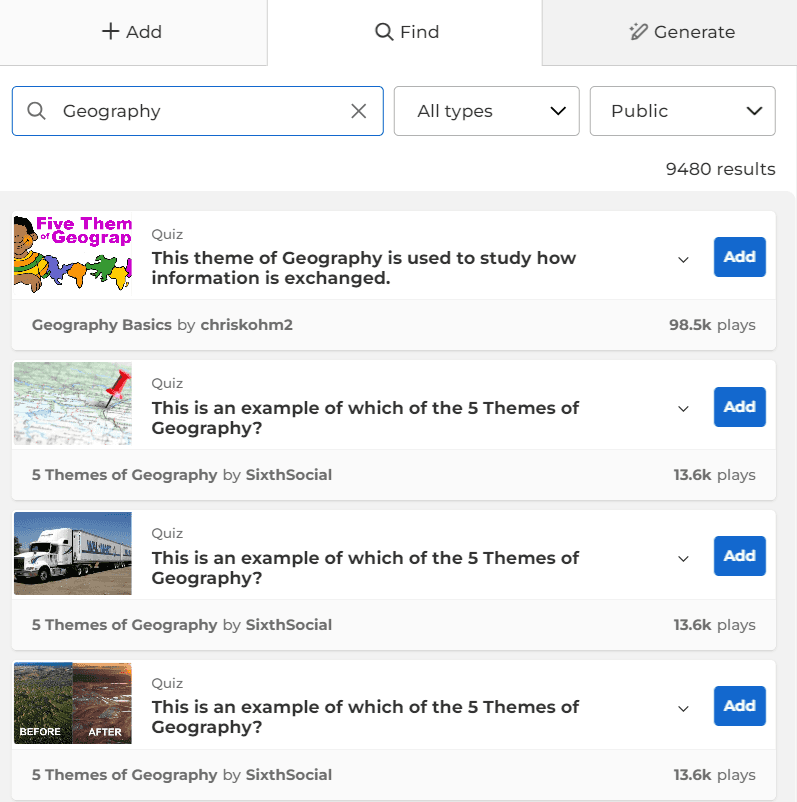
With the Al-powered question generator, you can create questions or entire games by providing a:
- Topic — generates questions using the provided prompt,
- or PDF file — uses the information contained in the file to generate questions.
You can then further customize the generated questions, add media to them, and include more questions.
Wooclap's generative AI is more powerful.
It can generate multiple-choice or open-ended questions from topic, document, text, URL, audio, and video. Unlike Kahoot, which only supports PDF with file sizes less than 50 MB, Wooclap supports PDF, PowerPoint, Pages, Text, and OpenDocuments up to 200 MB. And that’s only for the documents—you can add audio and video files in several additional formats.
It also lets you customize the type of question you want to generate and specify the number of correct and incorrect answers.
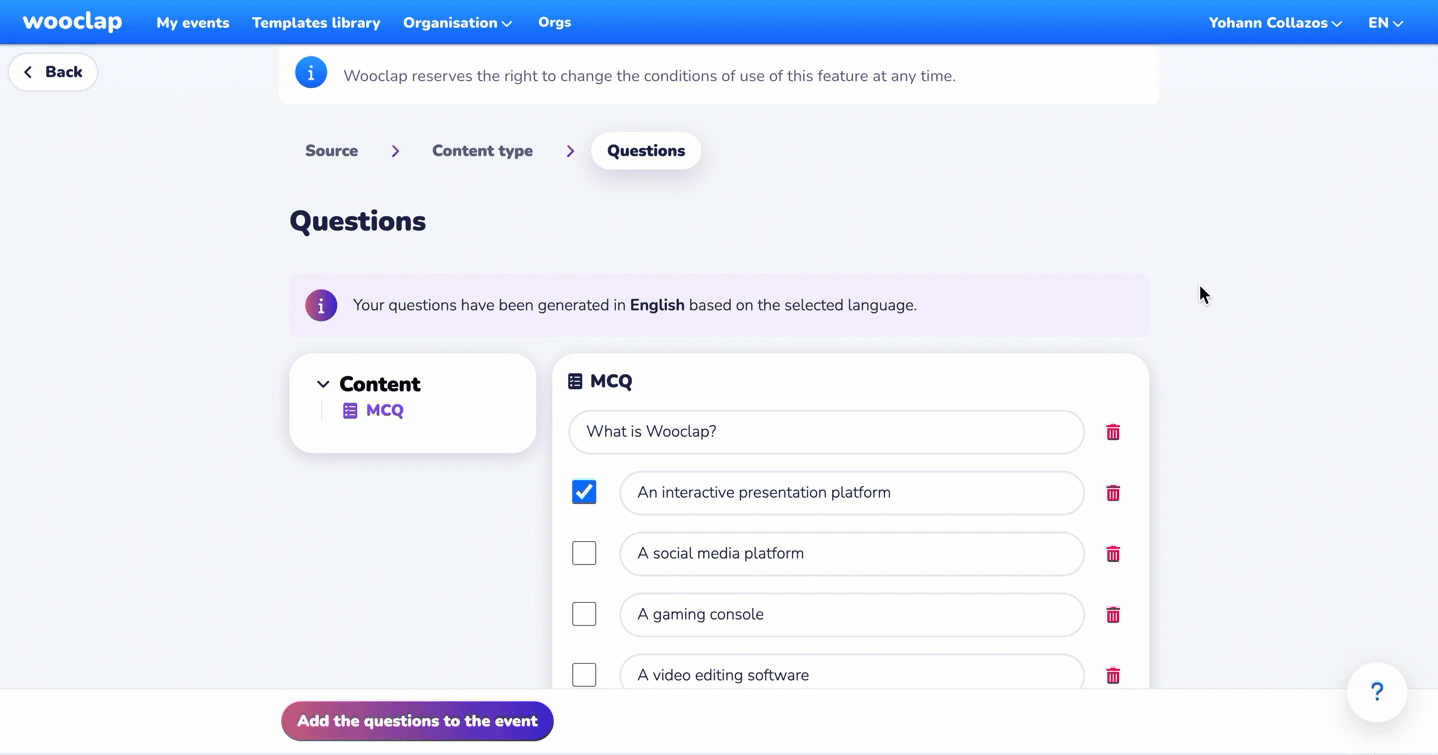
In addition to the generative AI, Wooclap also lets you import questions from previous events, Excel, Brightspace, and Wooflash—an intelligent micro-learning platform from the developers of Wooclap.
Unlike Kahoot and Wooclap, Poll Everywhere doesn't have an AI assistant. Instead, it generates a few options for each question with placeholder text.
Wooclap’s unique and plentiful question types and gamified but professional features make it perfect for higher education and corporate use. Kahoot has an expansive public question bank, but with a heavily gamified experience that works out better for K-12 education
Poll Everywhere vs Kahoot vs Wooclap: Reporting
| Poll Everywhere | Kahoot | Wooclap |
| ⭐️⭐️⭐️⭐️⭐️ | ⭐️⭐️⭐️ | ⭐️⭐️⭐️⭐️⭐️ |
Kahoot offers basic reports, Poll Everywhere is more detailed, while Wooclap reports all interactions.
Kahoot offers three report types (1):
- Players — ranks players by percentage and raw scores,
- Questions (2) — displays each question with the percentage of correct answers,
and Feedback — displays the saved feedback from students.
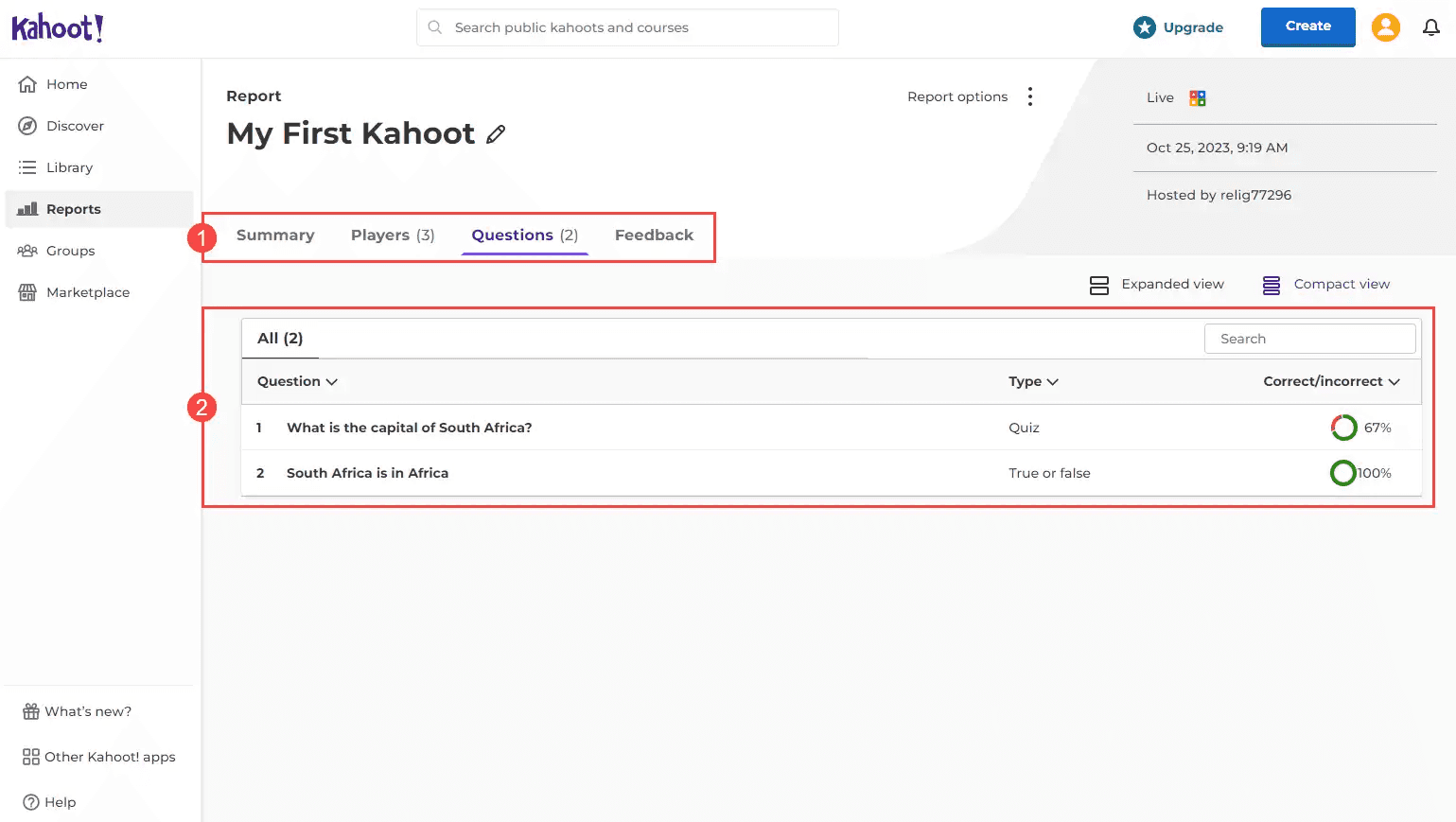
It also provides a summary view of all this data and lets you export reports as an Excel file for further review.
Poll Everywhere provides five report types for visualizing participant responses to questions.
- Executive summary — big-picture overview of engagement, responses, and participants with a screenshot of each question.
- Audience response — one section per participant with one line per question.
- Response pivot table — full detail view with one row per response, useful for grouping or computing sums and averages.
- Participant response history — one section per participant, shows when and how each response was submitted.
- Gradebook — compact table with participants listed on the left and questions across columns.
It lets you export any report as CSV for manipulation in spreadsheet software like Excel.
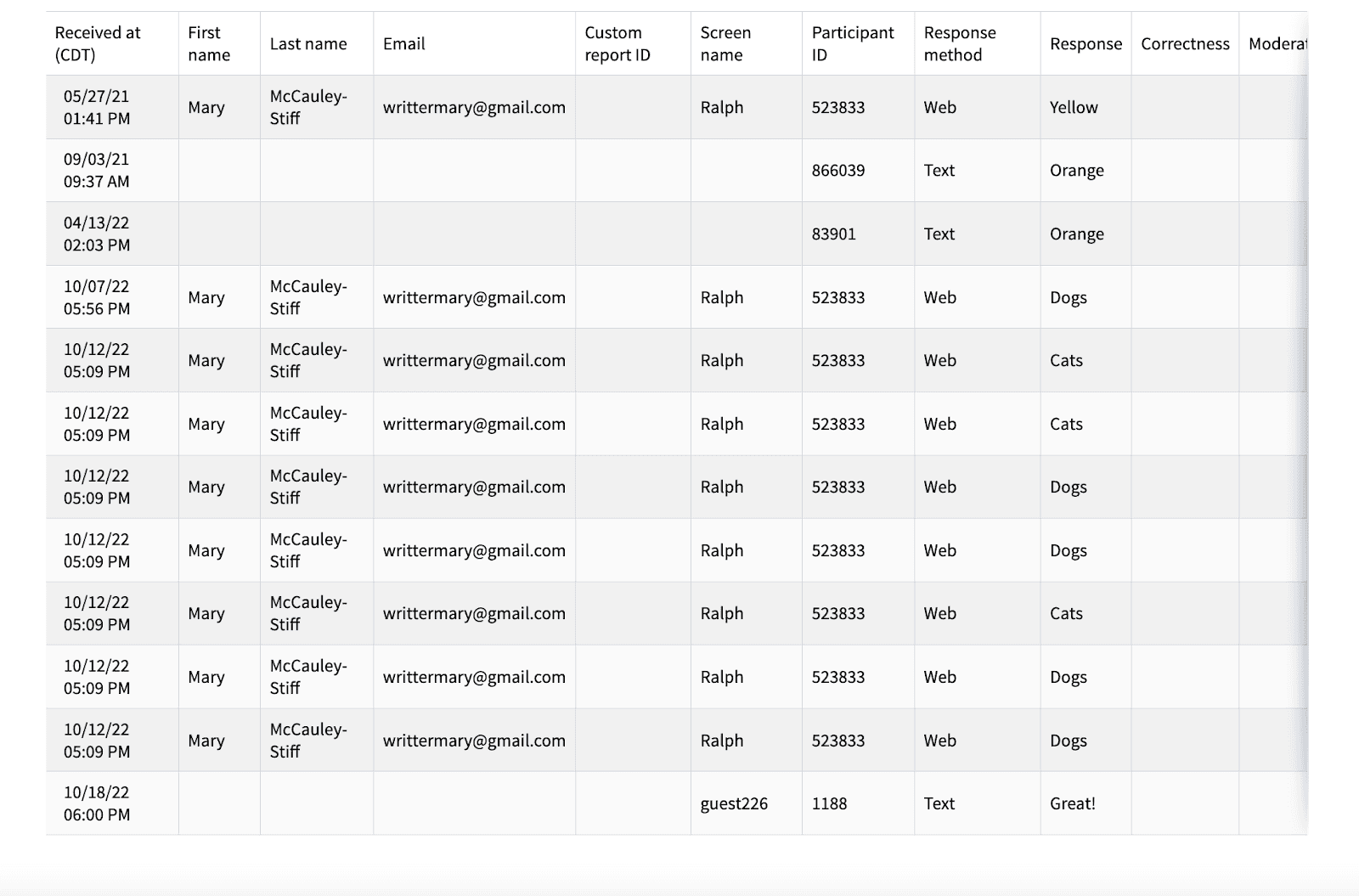
Like Kahoot and Poll Everywhere, Wooclap’s Views and reports feature tracks your students’ understanding of each question. It provides four Views of participant responses:
- Full presentation — shows the results of Q&A sessions within the presentation used.
- Questions — shows all the results of your event based on the questions you created.
- Participants — quickly filter the answers per participant.
- Grid — lets you review the data per question and per participant.
If you set up authentication for your event, you can send individual reports to participants with just a click, which makes it perfect for instant feedback after lectures or seminars. You can download these reports as Excel and PDF files.
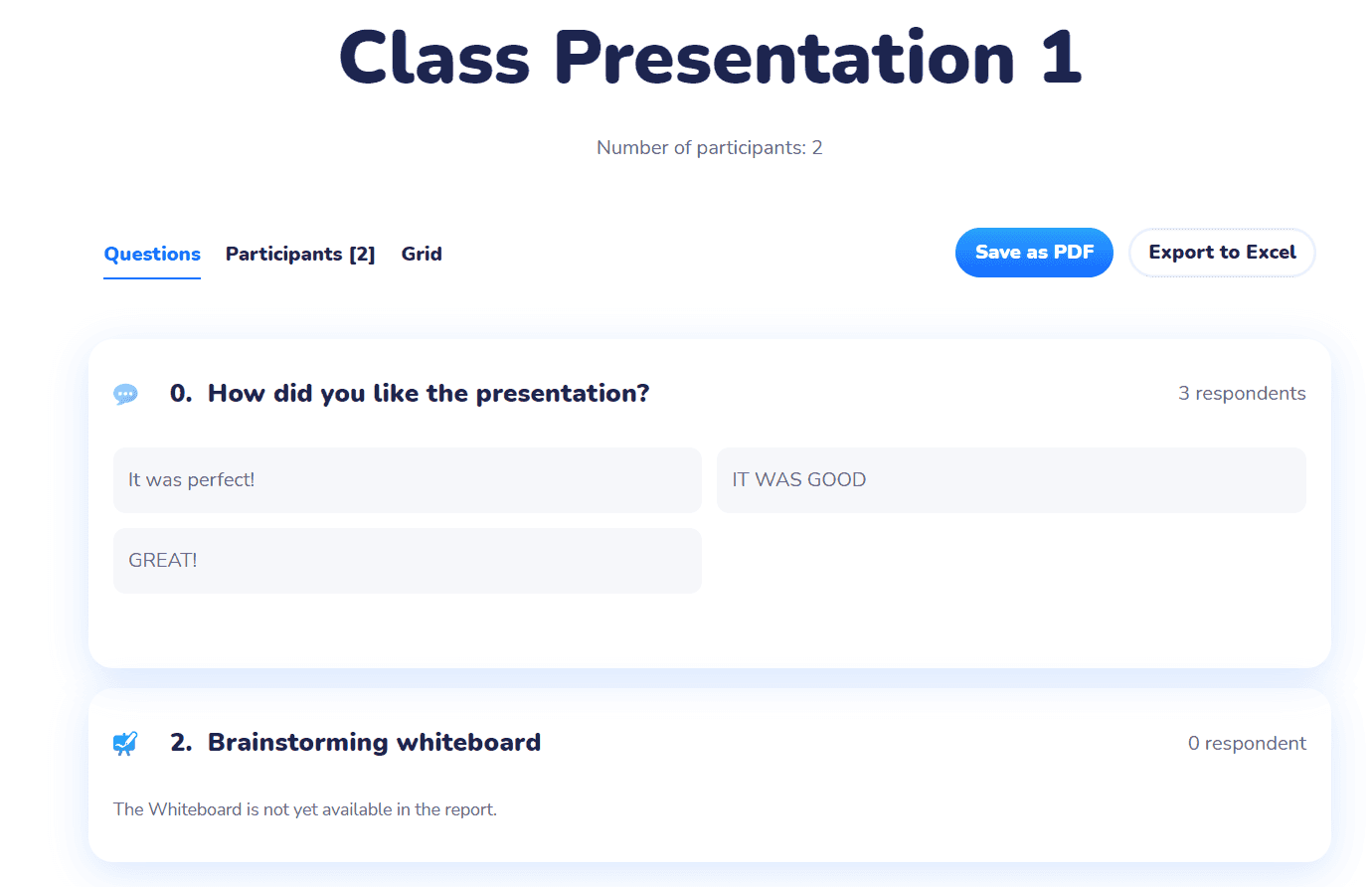
In addition to question reports, Wooclap lets you export event messages to Excel. You can also export results from surveys created in the Participant Pace section.
Wooclap is the only platform here that lets you export the results of all events at once. This way, you can see the results of every interaction each student had with your events over a given period.
Wooclap offers reports on the event, messages during the event, and questionnaires in the participant pace section. Poll Everywhere offers more detailed reports with a Gradebook for each participant.
Poll Everywhere vs Kahoot vs Wooclap: Pricing
| Poll Everywhere | Kahoot | Wooclap |
| ⭐️⭐️⭐️⭐️ | ⭐️⭐️⭐️ | ⭐️⭐️⭐️⭐️⭐️ |
Poll Everywhere, Kahoot, and Wooclap offer free plans.
Poll Everywhere’s free plan lets you create unlimited questions for up to 25 participants. You get access to all question types and can export screenshots of responses. However, the functionality is very limited—you can’t create reports, register participants, or moderate responses.
Kahoot’s free plan for schools lets you create unlimited events, view reports, set up team mode, and access the question bank. However, the functionality on the free version is limited—you only get access to multiple-choice question types, and a live event is limited to 40 participants.
Wooclap’s free plan unlocks all question types and allows you to add 2 questions per event but you can create unlimited events. And, unlike Kahoot, the free plan lets you import slides and host up to 1,000 participants per event.
Poll Everywhere offers multiple pricing structures based on organization type and use case.
Poll Everywhere offers four pricing structures for businesses, higher education, K-12 education, and one-time use. All pricing structures, except the one-time use, offer free accounts.
Here’s a breakdown of Poll Everywhere’s business & non-profit plans:
| Intro | Present | Engage | Teams | Enterprise |
Free Unlimited users 25 max audience size FAQ, support center, and webinar tutorials | $10/mo Add more users at $120/year 700 max audience size Email support | $99/mo 1 free additional user Add more users at $50/mo Attendance management and reporting Moderating responses Restrict responses to registered participants | $249/mo 1 free additional user Add more users at $125/mo Pinned questions during presentation Custom response URL and branding | Custom Custom max audience size Dedicated account manager and priority support |
If you’re hosting a one-off event with a large audience, you can opt for the one-time pricing plans which offer unlimited questions for 1,000 participants or more. You also get access to the full range of Poll Everywhere’s features. The pricing ranges from $499 to $4,999+.
For uses in the education sector, Poll Everywhere’s paid plans vary between higher education and K-12 institutions. For higher education, the individual instructors will pay $349 per semester, or the pricing can be divided among the students. Department-wide licenses go from $5,000 up. For K-12, the individual teachers will pay $50 per year. School-wide pricing goes from $1,000 up.
Poll Everywhere’s pricing is easier to understand than Kahoot’s but still more complicated than Wooclap’s pricing structure.
Kahoot’s paid plans unlock more participants and features, but choosing a plan is difficult because of the complicated pricing structure.
Kahoot offers two main pricing structures:
Both of these are grouped based on two use cases:
- Individual, for teachers and professionals,
- and Team, for professional groups and schools.
Here’s a breakdown of Kahoot’s Education individual and team pricing structures:
| Basic | Start | Premier | Max |
Free 40 participants per session | $3.99/mo/teacher 100 participants per session | $7.99/mo/teacher 200 participants per session | $12.99/mo/teacher $12.99/mo/teacher |
| Basic | EDU Standard School & District | EDU Pro School & District |
Free 40 participants per session | $12.99/mo/teacher 5 licenses 800 participants per session | $17.99/mo/teacher 5 licenses 2000 participants per session |
And here��’s a breakdown of Kahoot’s Business individual and team pricing structures:
| Starter | 360 Standard | 360 Presenter | 360 Pro | 360 Pro Max |
$10/mo/host 20 participants per session | $17/mo/host 20 participants per session | $24/mo/host (only annual plan) 50 participants per session | $49/mo/host (only annual plan) 2000 participants per session | $79/mo/host (only annual plan) 2000 participants per session |
| 360 Presenter | 360 Pro for Teams | 360 Spirit | 360 Spirit Premium |
$19/mo/member 5 licenses 50 participants per session | $39/mo/member 5 licenses 2000 participants per session | $20/mo/member 50 licenses 100 participants per session | $49/mo/member 100 licenses 10,000 participants per session |
We haven’t even included the higher education, home, and study plans, which are further divided based on use case. Moreover, Kahoot offers premium and one-time plans.
As you can see, the biggest hurdle with Kahoot’s pricing is the complexity—finding the right plan is like trying to get through a maze. Having said that, it’s easy to see that the Education plans are more affordable.
Wooclap has the simplest pricing structure and offers the best value for money.
Wooclap’s pricing structure is easier to understand than Poll Everywhere’s and Kahoot’s. However, while the number of events is unlimited, Wooclap limits the number of participants to 1,000 on the Basic and Pro plans.
| Basic | Pro | Enterprise | |
$9.99/mo/user Unlimited questions + Export to Excel and PDF + Participant pace questionnaires | $24.99/mo/user Basic + Custom branding + SMS voting + Team collaboration + Moderator | Custom Pro + Unlimited participants + LMS integration + SSO + Dedicated support | |
$ 6.99/mo/user Unlimited questions + Export to Excel and PDF + Participant pace questionnaires | $ 14.99/mo/user Basic + Custom branding + SMS voting + Team collaboration + Moderator | Custom Pro + Unlimited participants + LMS integration + SSO + Dedicated support |
Wooclap also offers pricing plans for one-off events depending on the number of questions and participants.
Poll Everywhere vs Kahoot vs Wooclap: Pros & Cons
 | |
| Poll Everywhere Pros | Poll Everywhere Cons |
✅ Unlimited questions on all plans | ❌ Free version is limited to 25 participants |
✅ Detailed reports on participant responses | ❌ Limited event management tools |
✅ Track questions with a native timer | ❌ Can’t import presentation slides |
✅ Lots of native integrations | ❌ No AI-assisted event creation tools |
✅ Two-way interaction during live events | ❌ No event templates |
 | |
| Kahoot Pros | Kahoot Cons |
✅ Unlimited events on the free plan | ❌ Free plan is limited to 2 question types |
✅ Background music during events | ❌ No real-time interactions during live events |
✅ Randomize the order of questions | ❌ Slide imports not available on the free plan |
✅ Students can create avatars for events | ❌ Limited native integrations |
✅ AI-generated events and questions | ❌ Complicated pricing plan |
 | |
| Wooclap Pros | Wooclap Cons |
✅ Lots of question types and feedback tools | ❌ Free plan is limited to 2 questions per event |
✅ Lots of event and question templates | ❌ Can’t view presenter notes on mobile devices |
✅ Host up to 1,000 participants on the free plan | |
✅ Categorize messages in the Presenter view | |
✅ Send individual performance reports to your audience after events | |
✅ Competition mode for active engagement | |
✅ Lots of integrations with LMS, presentation, and video conferencing platforms | |
Final Verdict: Poll Everywhere vs Kahoot vs Wooclap
| Poll Everywhere | Kahoot | Wooclap |
Best for: Marketers that need a quick and easy platform for creating interactive webinars. | Best for: Teachers and schools in the K-12 sector wanting to improve student participation and engagement in classrooms. | Best for: Higher education lecturers and professional instructors who want to boost active participation and knowledge retention during teaching sessions. |
Poll Everywhere lacks robust event features but is great at creating surveys, opinion polls, and open-ended responses, making it a quick and easy tool for collecting audience feedback.
Kahoot’s gamification features, such as custom character creation and leaderboards, make it ideal for sparking fun, excitement, and engagement in classroom sessions.
Meanwhile, Wooclap’s diverse question types, LMS integrations, and detailed reports make it easy for professors, lecturers, and corporate trainers to create comprehensive assessments while tracking performance across the board.
Use Poll Everywhere if:
- You want detailed reports on participant responses.
- You want to create interactive webinars.
- You want to create one-time events.
Click here to get started with Poll Everywhere!
Use Kahoot if:
- You’re teaching students at the K-12 level.
- You’re looking for a heavily gamified experience to make learning fun.
- You don’t need real-time messaging for students during learning sessions.
Click here to get started with Kahoot!
Use Wooclap if:
- You’re a lecturer or instructor, teaching complex topics.
- You want the flexibility to engage your audience on complex and diverse concepts during events.
- You want to gain an in-depth insight into your audience’s understanding so you can adapt your teaching methods and provide valuable feedback.
Writer

The Wooclap team
Make learning awesome & effective
Subject
A monthly summary of our product updates and our latest published content, directly in your inbox.
